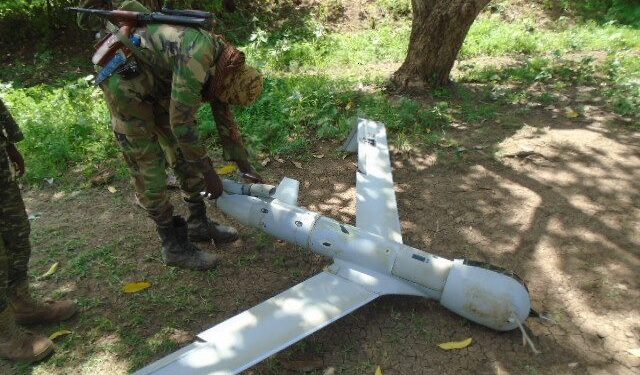What if the skies above Africa transformed into a battleground, where silent drones dictate the terms of safety and security? While attention tends to centre on overt terrorist actions, a hidden yet equally serious menace is rising: drones. These unmanned aerial vehicles (UAVs) are no longer reserved for government forces; they have turned into instruments of terror, altering the tactics of extremist organisations throughout the continent. This escalating challenge complicates the application of traditional counter-terrorism methods and prompts vital questions about our preparedness to confront these new airborne dangers (Australian Army Research Centre, 2024).
Drones, once hailed for their technological innovation, are now being utilised as weapons by groups such as Boko Haram, al-Shabaab, and the Islamic State West Africa Province (ISWAP). These organisations have integrated drones into their activities, employing them for surveillance, propagating their message, and potentially conducting offensive operations (Schwartz et al., 2024). Imagine a drone quietly observing a military facility and relaying real-time intelligence to ground attackers. This scenario is no longer just a theory; it is a current reality in certain regions of Africa. However, very few people consider how this technology came to be in their possession or what it signifies for future security across the continent.
Additionally, drones are not merely operational assets; they function as significant tools of persuasion. By recording aerial views of assaults or military confrontations, these organisations enhance their propaganda campaigns. Clips displaying their “victories” spread rapidly on the internet, attracting recruits and instilling fear well beyond their local zones of action. The psychological effect is immense—both civilians and security personnel are left questioning their safety under the open sky (Greenberg Research, 2023).
The dangers linked to drone technology go beyond simple monitoring. Experts caution that it’s only a matter of time before these groups completely arm drones for aggressive actions. In other conflict areas such as the Middle East, terrorist groups have already utilised commercial drones to release explosives on targets, causing catastrophic consequences (Brown University Report, 2024). The possibility of similar strategies being employed in Africa is concerning. Given the porous borders and weak governance in regions like the Sahel, it becomes relatively straightforward to smuggle drone parts or modify commercial models for military use.
Terrorist groups in Africa are increasingly using drones to enhance their operations, adapting this technology for surveillance, reconnaissance, and even direct attacks. The key question is why action is not being taken against this trend? The difficulty stems from the unseen aspect of this threat. While many comprehend the direct hazards of roadside bombs or armed attacks, the idea of drones being utilised as instruments of terror seems abstract to numerous policymakers and the general public (Tufts Now, 2025). This lack of awareness is further exacerbated by the scarce resources and knowledge available to African governments to effectively address these threats. Although counter-drone technologies are available, they tend to be costly and largely out of reach for countries that are already burdened by ongoing conflicts.
The global community needs to enhance its response to this emerging threat. Joint initiatives between African countries and international partners could ensure access to counter-drone technologies and provide training programs for security forces (Australian Army Research Centre, 2024). However, relying solely on technology will not resolve the issue. It is vital to implement public awareness campaigns to inform communities about the dangers associated with drones and the ways they can safeguard themselves. Just as cybersecurity awareness has become a cornerstone of modern education, understanding drone risks should be part of broader counter-terrorism strategies.
The growing risk of drones being used in terrorism across Africa is not solely an issue for the continent; it is a matter of global concern. As drone technology advances and spreads, its misuse is certain to create challenges that extend beyond Africa (ResearchGate, 2025). Tackling this issue demands prompt action, creativity, and cooperation at every level—from local communities to worldwide organisations.
The skies over Africa reflect a narrative of both opportunity and danger. Drones could transform sectors like agriculture and emergency management; however, if used improperly, they can turn into instruments of fear and devastation.
It has become a critical imperative for African governments, particularly the government of Ghana to take immediate action within the ambit of the national security council, parliament and the security services. This is due to Ghana’s proximity to nations where terrorist activities are recurrent. Key actions include the following;
- The development and deployment of anti-drone technologies. These should include but not limited to jamming and GPS spoofing that interferes with a drone’s communication and navigation systems. The Ghana Civil Aviation Authority (GCAA) requires licensing for the use of drones but this is largely ignored, particularly by commercial operators who use it for covering events, videos and pictures. Additionally, drone detection systems on radar as well as drone interception technologies are highly recommended for forestall any surprise attacks.
- Improvement in Border and Airspace Control systems are key imperatives. Ghana particularly has a border boundary commission that should be tasked with cooperating with other cross border organisations in this connection.
- Drone Detection Capacity development – It is critical that key personnel within the intelligence services are trained and sent on attachment for further analytical training to detect and identify enemy drones or remedial action wherever necessary.
- Regulatory measures are critical to entrenching legal action against any persons flying drones illegally. As indicated earlier, the GCAA has outlined measures, but the Parliaments in Africa need to work to ensure such measures are encased in law. Additionally, these laws must be made to bite.
- Public Education is also relevant, particularly in a democracy where free speech and human rights could be abused. The collective security of all is paramount and must be explained as part of a public education campaign to bring all to the table.
By acknowledging this complexity and taking preventative actions now, we can help ensure that drones serve as emblems of advancement rather than tools of violence. In the realm of national security, being complacent is not an option, and neither is being inactive.
References
Australian Army Research Centre (2024). Drones in modern warfare. Retrieved from https://researchcentre.army.gov.au/library/occasional-papers/drones-modern-warfare
Schwartz, J.A., Fuhrmann, M., & Horowitz, M.C. (2024). Drones: Pros, cons, debate. Encyclopedia Britannica.
Tufts Now (2025). How drones are changing warfare. Retrieved from https://now.tufts.edu/2025/01/21/how-drones-are-changing-warfare
ResearchGate (2025). Drones’ contribution to contemporary warfare. Retrieved from https://www.researchgate.net/publication/378424667_Drones’_contribution_to_the_transformation_of_contemporary_warfare
Brown University Report (2024). Weaponized drones in conflict zones. Retrieved from https://brown.edu/reports/weaponized-drones
Greenberg Research (2023). Psychological impacts of UAV surveillance. Retrieved from https://greenbergresearch.com/psychological-impacts-uav






























